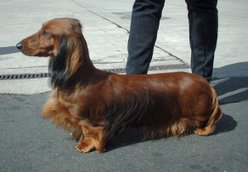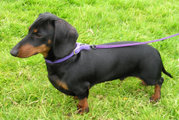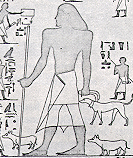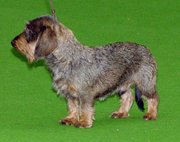
|
From Wikipedia the free encyclopedia, by MultiMedia |
| Dachshund | ||
|---|---|---|

Long-haired standard dachshund
|
||
| Alternative names | ||
| Country of origin | ||
| Germany | ||
| Common nicknames | ||
| Doxie | ||
| Classification and breed standards | ||
| FCI: | Group 4 Section 1 #148 | |
| AKC: | Hound | |
| ANKC: | Group 4 - (Hounds) | |
| CKC: | Group 2 - (Hounds) | |
| KC (UK): | Hound | |
| NZKC: | Hounds | |
| UKC: | Scenthound Breeds | |
| Not recognized by any major kennel club | ||
| This breed of Dog is extinct | ||
| Notes | ||
| ... | ||
The Dachshund is a short-legged, elongated Dog breed of the hound family. The breed's name is German and literally means "badger Dog" (der Dachs - badger; der Hund - Dog). The breed was developed to scent, chase, hunt, and kill badgers and other hole-dwelling animals. Due to their long, narrow build, they are sometimes referred to in the United States and elsewhere as "wiener Dogs" or "sausage Dogs".
 Black and tan Miniature smooth-haired dachshund
Black and tan Miniature smooth-haired dachshund
A full-sized Dachshund averages 12 to 24 lb (5 to 10 kg), while the Miniature variety typically weighs less than 12 lb (5 kg). Modern Dachshunds are characterized by their crooked legs, loose skin and barrel-like chest, attributes that were deliberately added to the breed to increase their ability to burrow into tight spaces. They come in three coat varieties: Smooth, Longhaired and Wirehaired; the Wirehaired variety is generally shorter in spine length than the other two. H. L. Mencken said that "A dachshund is a half-Dog high and a Dog-and-a-half long," which is their main claim to fame.
Dachshunds are loyal, playful fun Dogs, known for their propensity to chase small animals and birds. According to the American Kennel Club's breed standards, "the Dachshund is clever, lively and courageous to the point of rashness, persevering in above and below ground work, with all the senses well-developed. Any display of shyness is a serious fault."[1] Individuals which are indulged may become snappy[2]. Coat type is often considered to be associated with characteristic temperaments; the long-haired variety, for instance, is considered to be less excitable than the other types because it was cross-bred with the Spaniel to obtain its characteristic long coat. Some who own long-haired Dachshunds might disagree with this statement, however. Because of the breed's characteristic barrel-like chest, the dachshund's lungs are unusually large, making for a sonorous bark.

The breed is known to have spinal problems, due in part to an extremely long spinal column and short rib cage. The risk of injury can be worsened by obesity, which places greater strain on the vertebrae. In order to prevent injury, it is recommended that Dachshunds be discouraged from jumping and taking stairs. It has become increasingly apparent that the occurrence and severity of these problems is largely hereditary, and responsible breeders are working to eliminate this characteristic in the breed.
 Wire-haired Dachshund
Wire-haired Dachshund
Some have theorized that the early roots of the Dachshund go back to Ancient Egypt, where engravings were made featuring short-legged hunting Dogs. But in its modern incarnation, the Dachshund is a creation of European breeders, and includes elements of German, French and English hounds and terriers. Dachshunds have been kept by royal courts all over Europe, including that of Queen Victoria, who was particularly enamored of the breed.
The first verifiable references to the Dachshund, originally named the "Tachs Kriecher" (badger crawler) or "Tachs Krieger" (badger catcher), come from books written in the early 1700s. Prior to that, there exist references to "badger Dogs" and "hole Dogs", but these likely refer to purposes rather than to specific breeds. The original German Dachshunds were larger than the modern full-size variety, weighing between 30 and 40 lb (14 to 18 kg), and originally came in straight-legged and crook-legged varieties (the modern Dachshund is descended from the latter). Though the breed is famous for its use in exterminating badgers, Dachshunds were also commonly used for rabbit and fox hunting, for locating wounded deer, and in packs were known to hunt game as large as wild boar.
Dominant colors and patterns include Red and Black & Tan. Older traditional patterns such as piebald and sable are recently gaining in popularity. Recently, other color and pattern combinations have been developed; it is not uncommon to see Dachshunds with Brown & Tan, Chocolate & Tan, dapple, double dapple, and even white coats. Unfortunately, some of these colors require extensive inbreeding to obtain; double dapples are often born eyeless or with severely underdeveloped eyes. For this reason, the double dapple coat is extremely disfavored among responsible breeders and owners.
According to kennel club standards, the Miniature variety differs from the full-size only by size and weight.
Dachshunds have traditionally been viewed as a symbol of Germany, despite their pan-European heritage. During World War I the animals fell so far out of favor in England and the United States that dachshunds were stoned to death on the street [3]. Many Americans began referring to Dachshunds as "liberty pups", and political cartoonists commonly used the image of the Dachshund to ridicule Germany. The stigma of the association was revived to a much reduced extent during World War II, and it quickly faded away following the war's end. German Field Marshal Erwin Rommel was also known for keeping Dachshunds.
The Dachshund for this association with Germany was chosen to be the first official mascot for 1972 Summer Olympics with the name "Waldi"
One of the odder controversies that has recently arisen in North America is the presence of Dachshund racing events.
This sport originated in a 1993 Miller Lite television commercial that listed odd possibilities for sports (including luge bowling), and has grown immensely in popularity since. It was featured in a half-time show for the San Francisco 49ers. You can see the commercial at the "Wiener Takes All" homepage (see external links below).
While some compare the sport to that of English and later American Greyhound racing, others see it having the possibility of harming the breed from strain placed on its spinal column. Others also see the possibility for abuse of racing Dachshunds, as evidenced by the large number of Greyhounds put to sleep every year once they have proven unsuitable for racing, and by those given up for adoption.
Dogs, made by MultiMedia | Free content and software
This guide is licensed under the GNU Free Documentation License. It uses material from the Wikipedia.